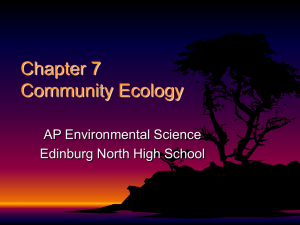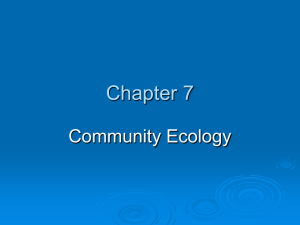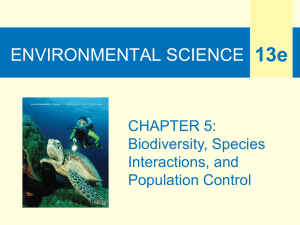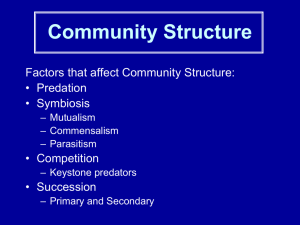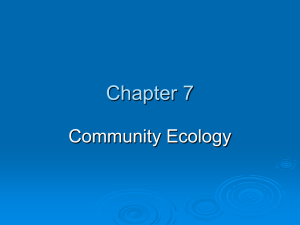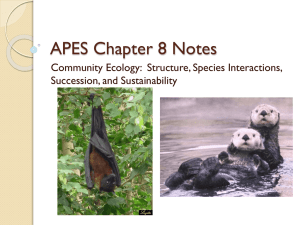Chapter 7
advertisement
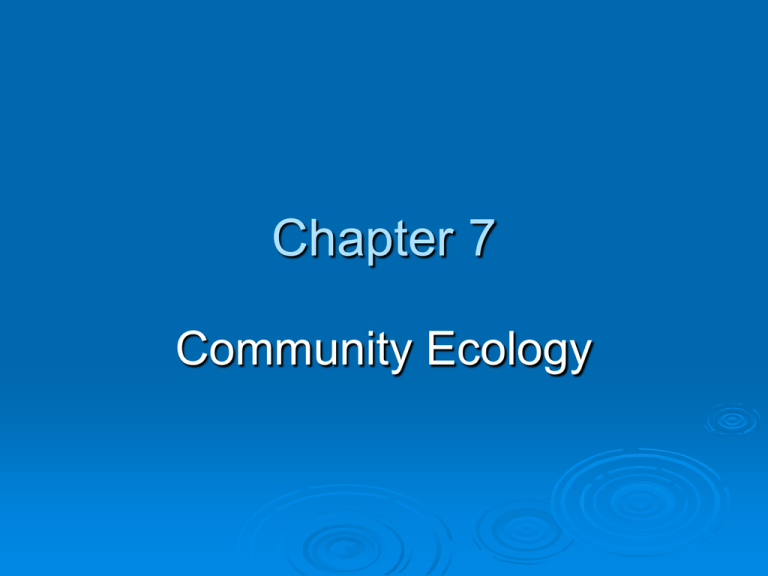
Chapter 7 Community Ecology Chapter Overview Questions What determines the number of species in a community? How can we classify species according to their roles in a community? How do species interact with one another? How do communities respond to changes in environmental conditions? Does high species biodiversity increase the stability and sustainability of a community? Updates Online The latest references for topics covered in this section can be found at the book companion website. Log in to the book’s e-resources page at www.thomsonedu.com to access InfoTrac articles. InfoTrac: California's wild crusade. Virginia Morell. National Geographic, Feb 2006 v209 i2 p80(16). InfoTrac: Traveling green. Carol Goodstein. Natural History, July-August 2006 v115 i6 p16(4) . InfoTrac: Too hot to trot. Charlie Furness. Geographical, May 2006 v78 i5 p51(7). The Nature Conservancy: Jaguar Habitat and Center of Maya Civilization Protected in Historic Land Deal National Geographic News: Conservationists Name Nine New "Biodiversity Hotspots" Video: Whaling This video clip is available in CNN Today Videos for Environmental Science, 2004, Volume VII. Instructors, contact your local sales representative to order this volume, while supplies last. Core Case Study: Why Should We Care about the American Alligator? Hunters wiped out population to the point of near extinction. Alligators have important ecological role. Figure 7-1 Core Case Study: Why Should We Care about the American Alligator? Dig deep depressions (gator holes). Hold water during dry spells, serve as refuges for aquatic life. Build nesting mounds. provide nesting and feeding sites for birds. Keeps areas of open water free of vegetation. Alligators are a keystone species: Help maintain the structure and function of the communities where it is found. COMMUNITY STRUCTURE AND SPECIES DIVERSITY Biological communities differ in their structure and physical appearance. Figure 7-2 Tropical Coniferous Deciduous Thorn rain forest forest forest forest Thorn scrub Tall-grassShort-grass Desert scrub prairie prairie Fig. 7-2, p. 144 Species Diversity and Niche Structure: Different Species Playing Different Roles Biological communities differ in the types and numbers of species they contain and the ecological roles those species play. Species diversity: the number of different species it contains (species richness) combined with the abundance of individuals within each of those species (species evenness). Species Diversity and Niche Structure Niche structure: how many potential ecological niches occur, how they resemble or differ, and how the species occupying different niches interact. Geographic location: species diversity is highest in the tropics and declines as we move from the equator toward the poles. TYPES OF SPECIES Native, nonnative, indicator, keystone, and foundation species play different ecological roles in communities. Native: those that normally live and thrive in a particular community. Nonnative species: those that migrate, deliberately or accidentally introduced into a community. Case Study: Species Diversity on Islands MacArthur and Wilson proposed the species equilibrium model or theory of island biogeography in the 1960’s. Model projects that at some point the rates of immigration and extinction should reach an equilibrium based on: Island size Distance to nearest mainland Indicator Species: Biological Smoke Alarms Species that serve as early warnings of damage to a community or an ecosystem. Presence or absence of trout species because they are sensitive to temperature and oxygen levels. Keystone Species: Major Players Keystone species help determine the types and numbers of other species in a community thereby helping to sustain it. Figures 7-4 and 7-5 Foundation Species: Other Major Players Expansion of keystone species category. Foundation species can create and enhance habitats that can benefit other species in a community. Elephants push over, break, or uproot trees, creating forest openings promoting grass growth for other species to utilize. Case Study: Why are Amphibians Vanishing? Frogs serve as indicator species because different parts of their life cycles can be easily disturbed. Figure 7-3 Adult frog (3 years) Sperm Young frog Tadpole develops into frog Sexual Reproduction Eggs Tadpole Fertilized egg Egg hatches development Organ formation Fig. 7-3, p. 147 Case Study: Why are Amphibians Vanishing? Habitat loss and fragmentation. Prolonged drought. Pollution. Increases in ultraviolet radiation. Parasites. Viral and Fungal diseases. Overhunting. Natural immigration or deliberate introduction of nonnative predators and competitors. Video: Frogs Galore PLAY VIDEO From ABC News, Biology in the Headlines, 2005 DVD. How Would You Vote? To conduct an instant in-class survey using a classroom response system, access “JoinIn Clicker Content” from the PowerLecture main menu for Living in the Environment. Do we have an ethical obligation to protect shark species from premature extinction and treat them humanely? a. No. It's impractical to force international laws on individual fishermen that are simply trying to feed their families with the fishing techniques that they have. b. Yes. Sharks are an important part of marine ecosystems. They must be protected and, like all animals, they should be humanely treated. SPECIES INTERACTIONS: COMPETITION AND PREDATION Species can interact through competition, predation, parasitism, mutualism, and commensalism. Some species evolve adaptations that allow them to reduce or avoid competition for resources with other species (resource partitioning). Resource Partitioning Each species minimizes competition with the others for food by spending at least half its feeding time in a distinct portion of the spruce tree and by consuming somewhat different insect species. Figure 7-7 Niche Specialization Niches become separated to avoid competition for resources. Figure 7-6 Number of individuals Number of individuals Species 1 Species 2 Region of niche overlap Resource use Species 1 Resource use Species 2 Fig. 7-6, p. 150 SPECIES INTERACTIONS: COMPETITION AND PREDATION Species called predators feed on other species called prey. Organisms use their senses their senses to locate objects and prey and to attract pollinators and mates. Some predators are fast enough to catch their prey, some hide and lie in wait, and some inject chemicals to paralyze their prey. PREDATION Some prey escape their predators or have outer protection, some are camouflaged, and some use chemicals to repel predators. Figure 7-8 (a) Span worm Fig. 7-8a, p. 153 (b) Wandering leaf insect Fig. 7-8b, p. 153 (c) Bombardier beetle Fig. 7-8c, p. 153 (d) Foul-tasting monarch butterfly Fig. 7-8d, p. 153 (e) Poison dart frog Fig. 7-8e, p. 153 (f) Viceroy butterfly mimics monarch butterfly Fig. 7-8f, p. 153 (g) Hind wings of Io moth resemble eyes of a much larger animal. Fig. 7-8g, p. 153 (h) When touched, snake caterpillar changes shape to look like head of snake. Fig. 7-8h, p. 153 SPECIES INTERACTIONS: PARASITISM, MUTUALISM, AND COMMENSALIM Parasitism occurs when one species feeds on part of another organism. In mutualism, two species interact in a way that benefits both. Commensalism is an interaction that benefits one species but has little, if any, effect on the other species. Parasites: Sponging Off of Others Although parasites can harm their hosts, they can promote community biodiversity. Some parasites live in host (micororganisms, tapeworms). Some parasites live outside host (fleas, ticks, mistletoe plants, sea lampreys). Some have little contact with host (dump-nesting birds like cowbirds, some duck species) Mutualism: Win-Win Relationship Two species can interact in ways that benefit both of them. Figure 7-9 (a) Oxpeckers and black rhinoceros Fig. 7-9a, p. 154 (b) Clownfish and sea anemone Fig. 7-9b, p. 154 (c) Mycorrhizal fungi on juniper seedlings in normal soil Fig. 7-9c, p. 154 (d) Lack of mycorrhizal fungi on juniper seedlings in sterilized soil Fig. 7-9d, p. 154 Commensalism: Using without Harming Some species interact in a way that helps one species but has little or no effect on the other. Figure 7-10 ECOLOGICAL SUCCESSION: COMMUNITIES IN TRANSITION New environmental conditions allow one group of species in a community to replace other groups. Ecological succession: the gradual change in species composition of a given area Primary succession: the gradual establishment of biotic communities in lifeless areas where there is no soil or sediment. Secondary succession: series of communities develop in places containing soil or sediment. Primary Succession: Starting from Scratch Primary succession begins with an essentially lifeless are where there is no soil in a terrestrial ecosystem Figure 7-11 Lichens Exposed and mosses rocks Fig. 7-11, p. 156 Secondary Succession: Starting Over with Some Help Secondary succession begins in an area where the natural community has been disturbed. Figure 7-12 Fig. 7-12, p. 157 Can We Predict the Path of Succession, and is Nature in Balance? The course of succession cannot be precisely predicted. Previously thought that a stable climax community will always be achieved. Succession involves species competing for enough light, nutrients and space which will influence it’s trajectory. ECOLOGICAL STABILITY AND SUSTAINABILITY Living systems maintain some degree of stability through constant change in response to environmental conditions through: Inertia (persistence): the ability of a living system to resist being disturbed or altered. Constancy: the ability of a living system to keep its numbers within the limits imposed by available resources. Resilience: the ability of a living system to bounce back and repair damage after (a not too drastic) disturbance. ECOLOGICAL STABILITY AND SUSTAINABILITY Having many different species appears to increase the sustainability of many communities. Human activities are disrupting ecosystem services that support and sustain all life and all economies.
